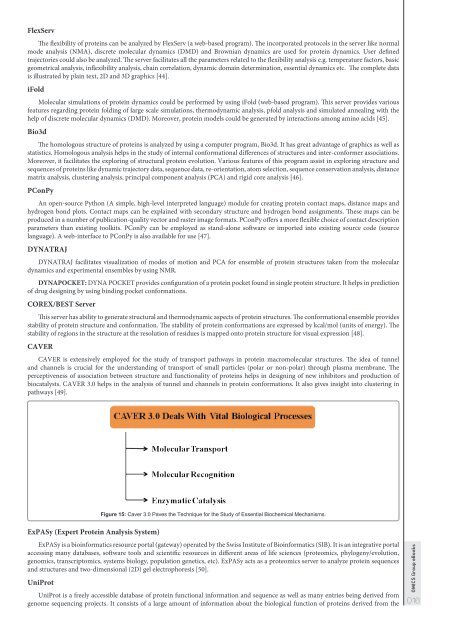You also want an ePaper? Increase the reach of your titles
YUMPU automatically turns print PDFs into web optimized ePapers that Google loves.
FlexServ<br />
The flexibility of prote<strong>in</strong>s can be analyzed by FlexServ (a web-based program). The <strong>in</strong>corporated protocols <strong>in</strong> the server like normal<br />
mode analysis (NMA), discrete molecular dynamics (DMD) and Brownian dynamics are used for prote<strong>in</strong> dynamics. User def<strong>in</strong>ed<br />
trajectories could also be analyzed. The server facilitates all the parameters related to the flexibility analysis e.g. temperature factors, basic<br />
geometrical analysis, <strong>in</strong>flexibility analysis, cha<strong>in</strong> correlation, dynamic doma<strong>in</strong> determ<strong>in</strong>ation, essential dynamics etc. The complete data<br />
is illustrated by pla<strong>in</strong> text, 2D and 3D graphics [44].<br />
iFold<br />
Molecular simulations of prote<strong>in</strong> dynamics could be performed by us<strong>in</strong>g iFold (web-based program). This server provides various<br />
features regard<strong>in</strong>g prote<strong>in</strong> fold<strong>in</strong>g of large scale simulations, thermodynamic analysis, pfold analysis and simulated anneal<strong>in</strong>g with the<br />
help of discrete molecular dynamics (DMD). Moreover, prote<strong>in</strong> models could be generated by <strong>in</strong>teractions among am<strong>in</strong>o acids [45].<br />
Bio3d<br />
The homologous structure of prote<strong>in</strong>s is analyzed by us<strong>in</strong>g a computer program, Bio3d. It has great advantage of graphics as well as<br />
statistics. Homologous analysis helps <strong>in</strong> the study of <strong>in</strong>ternal conformational differences of structures and <strong>in</strong>ter-conformer associations.<br />
Moreover, it facilitates the explor<strong>in</strong>g of structural prote<strong>in</strong> evolution. Various features of this program assist <strong>in</strong> explor<strong>in</strong>g structure and<br />
sequences of prote<strong>in</strong>s like dynamic trajectory data, sequence data, re-orientation, atom selection, sequence conservation analysis, distance<br />
matrix analysis, cluster<strong>in</strong>g analysis, pr<strong>in</strong>cipal component analysis (PCA) and rigid core analysis [46].<br />
PConPy<br />
An open-source Python (A simple, high-level <strong>in</strong>terpreted language) module for creat<strong>in</strong>g prote<strong>in</strong> contact maps, distance maps and<br />
hydrogen bond plots. Contact maps can be expla<strong>in</strong>ed with secondary structure and hydrogen bond assignments. These maps can be<br />
produced <strong>in</strong> a number of publication-quality vector and raster image formats. PConPy offers a more flexible choice of contact description<br />
parameters than exist<strong>in</strong>g toolkits. PConPy can be employed as stand-alone software or imported <strong>in</strong>to exist<strong>in</strong>g source code (source<br />
language). A web-<strong>in</strong>terface to PConPy is also available for use [47].<br />
DYNATRAJ<br />
DYNATRAJ facilitates visualization of modes of motion and PCA for ensemble of prote<strong>in</strong> structures taken from the molecular<br />
dynamics and experimental ensembles by us<strong>in</strong>g NMR.<br />
DYNAPOCKET: DYNA POCKET provides configuration of a prote<strong>in</strong> pocket found <strong>in</strong> s<strong>in</strong>gle prote<strong>in</strong> structure. It helps <strong>in</strong> prediction<br />
of drug design<strong>in</strong>g by us<strong>in</strong>g b<strong>in</strong>d<strong>in</strong>g pocket conformations.<br />
COREX/BEST Server<br />
This server has ability to generate structural and thermodynamic aspects of prote<strong>in</strong> structures. The conformational ensemble provides<br />
stability of prote<strong>in</strong> structure and conformation. The stability of prote<strong>in</strong> conformations are expressed by kcal/mol (units of energy). The<br />
stability of regions <strong>in</strong> the structure at the resolution of residues is mapped onto prote<strong>in</strong> structure for visual expression [48].<br />
CAVER<br />
CAVER is extensively employed for the study of transport pathways <strong>in</strong> prote<strong>in</strong> macromolecular structures. The idea of tunnel<br />
and channels is crucial for the understand<strong>in</strong>g of transport of small particles (polar or non-polar) through plasma membrane. The<br />
perceptiveness of association between structure and functionality of prote<strong>in</strong>s helps <strong>in</strong> design<strong>in</strong>g of new <strong>in</strong>hibitors and production of<br />
biocatalysts. CAVER 3.0 helps <strong>in</strong> the analysis of tunnel and channels <strong>in</strong> prote<strong>in</strong> conformations. It also gives <strong>in</strong>sight <strong>in</strong>to cluster<strong>in</strong>g <strong>in</strong><br />
pathways [49].<br />
Figure 15: Caver 3.0 Paves the Technique for the Study of Essential Biochemical Mechanisms.<br />
ExPASy (Expert Prote<strong>in</strong> Analysis System)<br />
ExPASy is a bio<strong>in</strong>formatics resource portal (gateway) operated by the Swiss Institute of Bio<strong>in</strong>formatics (SIB). It is an <strong>in</strong>tegrative portal<br />
access<strong>in</strong>g many databases, software tools and scientific resources <strong>in</strong> different areas of life sciences (proteomics, phylogeny/evolution,<br />
genomics, transcriptomics, systems biology, population genetics, etc). ExPASy acts as a proteomics server to analyze prote<strong>in</strong> sequences<br />
and structures and two-dimensional (2D) gel electrophoresis [50].<br />
UniProt<br />
UniProt is a freely accessible database of prote<strong>in</strong> functional <strong>in</strong>formation and sequence as well as many entries be<strong>in</strong>g derived from<br />
genome sequenc<strong>in</strong>g projects. It consists of a large amount of <strong>in</strong>formation about the biological function of prote<strong>in</strong>s derived from the<br />
OMICS Group eBooks<br />
016



